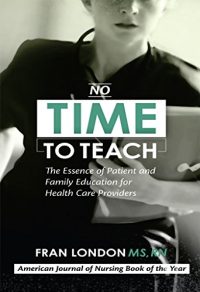Sometimes you pick up a book because someone recommends it, and it changes the way that you view a topic – and it changes the way you view the person who recommended the book. No Time to Teach: The Essence of Patient and Family Education for Health Care Providers is one of those books. Fran London is at the end of her career as a nurse educator and wrote the book to implore nurses and other providers to recognize the value of education – and to share what works.
Contradictions
It started early. I started disagreeing with London’s perspectives. Not just because it didn’t match my experience, but it also didn’t align with the best practices in training. Focused on one-on-one, face-to-face communications, London discounted the value of supporting materials. We know, for instance, from Job Aids and Performance Support that it’s worth assessing what is needed and what the best answer to that is – whether it’s training or a tool for getting the job done. In The Checklist Manifesto, Atul Gawande explains the value of checklists (a kind of performance aid) to the performance of all kinds of tasks. London tries to explain that you should individualize teaching – which is supported – but in a way that neither recognizes the ability to get leverage nor addresses the fundamental process of assessing what the patient and family know.
In The Art of Explanation, we learn that people can learn within a range. If the gap between their current knowledge is too great from what is being taught, it will be lost. That matches Malcolm Knowles et al.’s understanding of The Adult Learner, who needs to connect what they’re learning with what they know. Efficiency in Learning provides a path for developing materials to support teaching that can be used by people with varying experiences for effective learning – efficiently.
Ultimately, layered learning is the best approach. Learners’ current knowledge is assessed, and they’re given a set of resources and instructions that match their level – and provide the ability for self-reinforcement.

Assessing Knowledge
Too many professionals lead the witness when they ask if someone knows something. “You know how to take care of a wound, don’t you?” will lead to the obvious response, “Of course.” This response has nothing to do with the awareness of the needed skills but rather reflects the desire to not be perceived as stupid. I learned decades ago the best questions have “no” as the correct answer. They’re best, because in situations where understanding isn’t good or where shame or embarrassment may be a factor, people will default to a “yes” response.
There’s more to assessing knowledge than just a yes/no question. The next step is breaking down the knowledge they need to know into a set of specific skills that must be used – including the skills related to decision-making about situations and potential problems. Simple boundary conditions like “If they have trouble breathing, go to the emergency room immediately” or “If you don’t have a bowel movement in the first 12 hours, start with Miralax, and if you’ve not had a bowel movement in the first 36 hours, call the office to let us know” are great ways to help identify when action is necessary – and what the actions are.
You’re Not Too Stupid
People have a high degree of anxiety when interacting with health professionals. While they may be competent or even exemplary in their day-to-day jobs, often, the general public knows far less about health than health professionals believe. (They have the curse of knowledge.) It’s easy for the patient or the family to slip into thinking that the health professional is saying, “You are too stupid to understand this,” when that’s not what they’re trying to convey at all.
Whenever you’re struggling to communicate a set of skills to a patient or the patient’s family, it’s the teacher that is failing, not the student. The teacher needs to try harder – and to apologize to the patient for not making it easier to understand.
The Need to Teach
Too often, medical professionals see teaching (or even communicating with) the patient as secondary to their roles. Nothing could be further from the truth. The provider or nurse will see the patient for a limited time, but they’ll be with themselves for their entire life – and the families will spend substantially more time with them than they’ll ever get with a healthcare provider. The more these critical folks know, the less likely they are to have a negative outcome – or need to come back to the healthcare provider.
In the end, it’s only if bad outcomes are desired should someone say that they have No Time to Teach.


No comment yet, add your voice below!